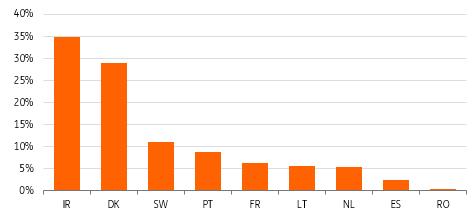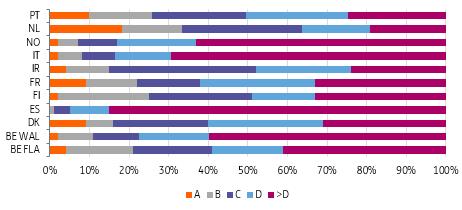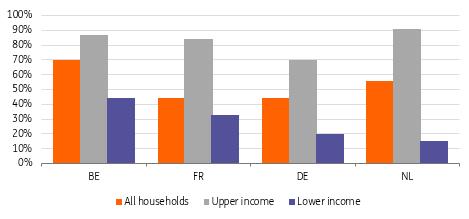(MENAFN- ING) Introduction
In order to reach its target to reduce its Green House gas (GHG) emissions by at least 55% by 2030, the EU designed the fit for 55 package. This initiative bundles a set of 12 proposals to revise European legislation. The review of the energy performance of buildings directive is an important part of it as buildings account for 40% of the energy consumed in the Union. Making the European building stock energy efficient and climate change resilient is therefore crucial to reach these goals. The Directive recast is still being negotiated however, we can expect five major changes to the current EPBD. From these, we can foresee effects on both society and financial institutions as they will have to play a major role to finance these upgrades.
The housing market differs a lot between member states, hence, the impact of the EPBD recast will also vary depending on the country. It's important to consider national specificities when addressing the potential effect of the Directive. Before looking into the potential effect on banks, six important variables must be considered to estimate the impact of the Directive.
1 Data availability
Making the transition towards zero-emission buildings (ZEB) includes many difficulties. Besides the enforcement challenges, national discrepancies exist in the number of Energy Performance Certificates (EPC) already available. Governments will need to generalise the use of EPC labels on top of complying with the new harmonised methodology and scale. As some states have already largely enforced the use of EPC in the field, the EU highlights the great lack of data in others. The graph below displays the energy performance data available per country. For residential buildings, Ireland and The Netherlands are good students with 41% and 34% of their respective national building stock with an EPC label. However, these shares date from 2015 and only show 16 of the 27 member states, and even if we can hope for a significant improvement over the last years, a large part of the EU building stock doesn't have a formal energy performance certificate or label.
Share of residential buildings with an EPC (2015)

European Commission, ING
Share of non-residential buildings with an EPC (2015)

European Commission, ING
The picture is even worse when looking at the non-residential buildings as the EU has less information on its member states labelling percentage. The graph above shows this issue well with only nine countries officially disclosing the share of non-residential buildings with an EPC label. Member states will have to invest in the enforcement of EPC requirements if they want to efficiently impose the new directive and set an adequate National Building Renovation Plan. Without sufficient and qualitative data, governments risk underestimating the necessary investment to renovate the national building stock and the need for financial incentives to do so. For financial institutions, the lack of adequate data could induce a misinterpretation of the portfolio quality and lower the Green Asset Ratio.
2 State of the current building stock
From the existing data and estimates, the general distribution of EPC also varies between countries. The graph below shows the EPC distribution for major EU countries. However, as there is currently no harmonised way to attribute EPC scores, these are the following national scales and methodologies. Despite not allowing a good cross-country comparison, it does give a first idea of the general national distribution.
National EPC labels distributions

X-Tendo (March 2020) and SBAB green bond impact report, ING
One of the main outcomes from the above graph is the significant share, for most countries, of D and below grades. Hence, a large part of every national building stock will have to go through energy performance renovation to comply with the regulation. A study from Tado looked into the home temperature loss after five hours and found that on average countries like Belgium and France have a significant loss of 2.9 and 2.5 degrees, respectively. However, Norway shows an average loss of only 0.9 degrees. Comparing these results to the above graph, we can highlight the significant differences in EPC labelling as France has better EPC labels than Norway but worse
energy saving. The Netherlands shows the highest rate of EPC label A. However, this is also strongly related to the national labelling scale which will change with the EPBD-related harmonisation of EPC scales. Therefore, for the Netherlands, most houses currently labelled A are expected to become labelled D under the new scaling.
3 Housing prices
In most European countries, the nominal house price has strongly increased since 2015 as the below graph shows.
Nominal house price change*
European Commission, ING
* With 2015 nominal prices as baseline index at 100
As these price increases are mostly related to general market trends, we can already see an EPC premium arise on houses with a good label in some countries. For example, a study from the National Bank of Belgium and KULeuven looked at the price differences between houses with high and lower energy performances. By comparing prices to a house with an EPC score of 350kWh/m2 between the third quarter of 2020 and the second quarter of 2021, their calculations highlighted the following results:
Energy efficiency impact on selling price in Belgium
NBB and KU Leuven, ING
This study clearly highlights the premium on energy-efficient houses with a net loss of value for the ones that are not energy efficient. This type of effect is clear in countries with a rather large enforcement of the EPC requirements. However, in countries like Spain, there is currently no such trend of energy efficiency premium, mostly due to non-existent or not disclosed EPC labels during the sale transaction. With the label and methodology harmonisation on top of wider and more transparent disclosures advocated by the EPBD, we can expect that other markets will display similar patterns. As shown previously, only very few member states already have public databases. As such, improving transparency will probably increasingly affect the market and valuation of buildings. Therefore, it constitutes a risk for financial institutions through the valuation of the collateral value of the mortgage portfolios in countries lacking EPC data. We can also expect the effect to differ per country, notably depending on the climate differences (as heating costs are lower in Mediterranean countries).
4 Renovation costs
The renovation costs of inefficient buildings are estimated to vary between €15,000 and €100,000
(VEKA & national sources). The required investments depend on the country, state and type of building. For instance, research from VEKA highlights that for the Belgian market, the cost of renovating a detached house can be up to 1.3 times more expensive than a terraced house. A higher share of apartment ownership is also a hindering factor for renovation as it may rise co-ownership decision barriers like unanimity vote on important building renovations.
This adds to the already existing national variations.
For Germany and The Netherlands, the average renovation costs lie between €15,000 and €30,000. They are higher in Belgium at an average of €50,000.
5 Ownership profile
The required investment is only one of the variables that will determine the feasibility of energy renovation. Another major point to look at is the national ownership profile. The Directive will first and most importantly affect the worst-performing regional stock. We can expect that countries with a high rate of low-income homeowners will face greater difficulties to fund the necessary renovations. We can already highlight some significant differences between major European markets. For instance, Belgium shows a high rate of low-income ownership with 44% of the lower-income population owning property. This is not the case for other markets such as Germany or the Netherlands which show, on average, low-income homeownership with respectively 20% and 15%. Additionally, these countries show lower homeownership rates in general, implying a larger rental market. This can have consequences on the tenant as landlords may be willing to make them bare the cost of renovations. The graph below shows the differences in homeownership rates.
National homeownership rates by type of homeowners (2015 or latest available)

OECD, ING
6 Access to liquidity
Overall, we can expect that countries with high renovation costs and an important share of low-income homeownership, like Belgium, will face greater difficulties to trigger energy renovation. It will also highly affect social justice in cases where the worst-performing buildings are owned by the most vulnerable population as these bear the highest refurbishing costs and are expected to be renovated sooner. However, it's also for these low EPC buildings that we will see a significant advantage to renovate, especially since the strong increase in energy prices. Reducing the energy need for a household will greatly limit spending. Access to liquidity is hence crucial to reach both the 2050 zero-emission target but also to make the transition just.
Research has already shown that in Belgium, 51% of households do not have sufficient savings to meet the energy renovation financing costs. Taking one-off debt investment into account, 40% of the population will still be unable to finance such an upgrade (Johan Albrecht, De financiële barriere voor klimaat). A similar observation can be made for The Netherlands where at least two
million households lack the financial means to renovate their house (NIBUD, 2021).
We can also estimate the difficulties households will face when requesting financial means to renovate by looking at the national average household debt. The OECD data shows that the household debt in percentage of the net disposable income has steadily increased over the last five years to reach exceptionally high rates in countries such as Denmark and The Netherlands, as shown in the graph below.
National household debt in percentage of net disposable income (2021)
OECD, ING
High household debt implies that it will be significantly more difficult for homeowners to fund important investments and to successfully request additional loans. National specificities such as a high level of mandatory saving for pensions can negatively affect a household's disposable income and thus impact the debt percentage.
Impact on financial institutions
These points will have a significant impact on society, but we can question what that means for financial institutions. Firstly, the change in the EPC scale will affect banks that have already started to collect EPC labels nationally for disclosure requirements showing their compliance with the EU Taxonomy. They will need to adapt to the new methodology and scale but considering this is a one-time investment, the cost should remain rather low. On top of this, the harmonisation of EPC scales will facilitate data comparability across countries. This positive impact will be especially important for international banks as it will support sustainability disclosures and ease cross-national portfolio comparison. However, it may negatively impact the green asset ratio of some banks as EPC label A will become strictly ZEB. This will solely be the case for countries where, for buildings built before the end of 2020, the current EPC label A definition covers a wider range of properties than the 15% best-in-class criterion on energy performance.
The implementation of minimum energy performance standards raises concerns about the valuation of the current portfolio. Indeed, for new loans, banks will be able to request an EPC and calculate possible renovation costs or simply use the renovation passport when available. However, for existent mortgages, even with an EPC, it will remain difficult to assess the necessary investment for it to reach the required minimum energy performance. As most countries have a rather low percentage of their building stock with an EPC, it will be a challenge for banks to set a realistic valuation. They will thus have to rely on proxies and possibly external providers to estimate the energy performance and renovation costs.
The EPBD review also allows member states to exclude certain buildings from EPC and minimum energy performance requirements. As this makes sense to protect their integrity it may provoke a large devaluation of historic buildings with the apparition of energy efficiency premiums on the market. Hence, depending on a bank's portfolio
composition, it could imply higher stranded asset risk for banks with a large share of EPBD-excluded buildings in their book.
Furthermore, banks are also expected to tackle the physical climate risk on their portfolio such as floodings, foundation rotting or wildlife fires (to name a few). As these risks are expected to intensify in the coming decade, financial institutions will have to simultaneously address the transition to a more sustainable portfolio while making it climate change resilient.
On the bright side, this Directive will open a new market of loans and renovation products. Knowing the future regulatory requirements, financial institutions can estimate and prepare for the upcoming renovation wave. The expected demand for energy upgrades will increase, thus is an opportunity for banks to start designing new products to adequately welcome this demand. It is also crucial for banks to take this opportunity to propose products allowing all homeowners to access the necessary financial means and take a concrete role in making this transition a just one.
Furthermore, as the regulation is fairly complex, financial institutions will also have an important informational role to play before and during the loan origination process. Even if the Directive review doesn't state direct penalties for infringements, not respecting or playing an active role in the enforcement of the new requirements can have a serious reputational effect. And, for institutions not meeting their stated sustainability targets, the European Central Bank recently expressed that they could face litigation risk. Hence, even if not directly affecting banks, the EPBD review could trigger tighter rules for financial institutions especially concerning the mapping of their transition plan as it implements more transparency.
In summary
The extent to which the review of the EPBD will affect financial institutions remains difficult to clearly assess. However, the implementation of strict minimum energy performance requirements is expected to trigger a higher renovation rate and we can foresee witnessing a gradual implementation of a premium to energy-efficient buildings on the housing market. For homeowners, the directive recast is especially challenging in two ways, the first one being the complexity of the policy. Indeed, a lot of information is required to understand and estimate the renovation and regulatory requirements. The second one consists of the liquidity needed to comply with the new policy. Financial institutions should play a role in both of these aspects, by bundling adequate information and innovative lending products to trigger renovations.
As there is currently still a lack of information on the market including EPC labels and renovation cost estimations, countries will need to invest in the matter to adequately organise their national building renovation plans and make sure the transition is a just one.